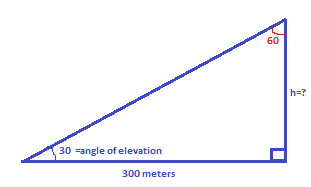
Answer
412.2k+ views
Hint: This problem is from heights and distances. We will easily solve this just by applying \[{30^ \circ } - {60^ \circ } - {90^ \circ }\] triangle theorem. That is side opposite to \[{60^ \circ }\] is \[{{{\sqrt 3 }} \!{\left/
{\vphantom {{\sqrt 3 } 2}}\right.}
\!\lower0.7ex{2}}\] times the hypotenuse and that opposite to \[{30^ \circ }\] is half of the hypotenuse. This is the simple and correct approach we will use here only because we know the angle of elevation.
Step by step solution:
Now let’s draw the figure first with a tower of height supposed to say h and the angle of elevation is \[{30^ \circ }\]. Also given that the distance is 300 meters from its foot on a horizontal plane.

This is the figure so formed. Now we will find the height of the tower with the help of hypotenuse of the figure.
Using our \[{30^ \circ } - {60^ \circ } - {90^ \circ }\] triangle theorem,
Side opposite to \[{60^ \circ }\]=300
\[ \Rightarrow {{{\sqrt 3 }} \!{\left/
{\vphantom {{\sqrt 3 } 2}}\right.}
\!\lower0.7ex{2}} \times hypt = 300\]
Thus value of hypotenuse is
\[ \Rightarrow hypt = 300 \times {{2} \!{\left/
{\vphantom {2 {\sqrt 3 }}}\right.}
\!\lower0.7ex{{\sqrt 3 }}}\]
Thus we get, \[ \Rightarrow hypt = {{{600}} \!{\left/
{\vphantom {{600} {\sqrt 3 }}}\right.}
\!\lower0.7ex{{\sqrt 3 }}}m\]
Now to get the height of the tower we will use this hypotenuse length.
Height of the tower is exactly the side opposite to the elevation angle \[{30^ \circ }\].
Side opposite to \[{30^ \circ }\]= \[{{1} \!{\left/
{\vphantom {1 2}}\right.}
\!\lower0.7ex{2}} \times hypt\]
\[ \Rightarrow h = {{1} \!{\left/
{\vphantom {1 2}}\right.}
\!\lower0.7ex{2}} \times hypt\]
Putting the value of hypotenuse
\[ \Rightarrow h = {{1} \!{\left/
{\vphantom {1 2}}\right.}
\!\lower0.7ex{2}} \times {{{600}} \!{\left/
{\vphantom {{600} {\sqrt 3 }}}\right.}
\!\lower0.7ex{{\sqrt 3 }}}\]
\[ \Rightarrow h = {{{300}} \!{\left/
{\vphantom {{300} {\sqrt 3 }}}\right.}
\!\lower0.7ex{{\sqrt 3 }}}m\]
This is the height of the tower \[ \Rightarrow h = {{{300}} \!{\left/
{\vphantom {{300} {\sqrt 3 }}}\right.}
\!\lower0.7ex{{\sqrt 3 }}}m\]
But there is no option matching here. Thus option D is the correct option “none of these”.
Note:
Students don’t hurry when you choose options because most of the students find the correct answer but fail to select. See here in this case the answer is in ratio form but since option B is similar looking people may tick it as correct. But it is the wrong one. So be careful when you choose the option.
{\vphantom {{\sqrt 3 } 2}}\right.}
\!\lower0.7ex{2}}\] times the hypotenuse and that opposite to \[{30^ \circ }\] is half of the hypotenuse. This is the simple and correct approach we will use here only because we know the angle of elevation.
Step by step solution:
Now let’s draw the figure first with a tower of height supposed to say h and the angle of elevation is \[{30^ \circ }\]. Also given that the distance is 300 meters from its foot on a horizontal plane.

This is the figure so formed. Now we will find the height of the tower with the help of hypotenuse of the figure.
Using our \[{30^ \circ } - {60^ \circ } - {90^ \circ }\] triangle theorem,
Side opposite to \[{60^ \circ }\]=300
\[ \Rightarrow {{{\sqrt 3 }} \!{\left/
{\vphantom {{\sqrt 3 } 2}}\right.}
\!\lower0.7ex{2}} \times hypt = 300\]
Thus value of hypotenuse is
\[ \Rightarrow hypt = 300 \times {{2} \!{\left/
{\vphantom {2 {\sqrt 3 }}}\right.}
\!\lower0.7ex{{\sqrt 3 }}}\]
Thus we get, \[ \Rightarrow hypt = {{{600}} \!{\left/
{\vphantom {{600} {\sqrt 3 }}}\right.}
\!\lower0.7ex{{\sqrt 3 }}}m\]
Now to get the height of the tower we will use this hypotenuse length.
Height of the tower is exactly the side opposite to the elevation angle \[{30^ \circ }\].
Side opposite to \[{30^ \circ }\]= \[{{1} \!{\left/
{\vphantom {1 2}}\right.}
\!\lower0.7ex{2}} \times hypt\]
\[ \Rightarrow h = {{1} \!{\left/
{\vphantom {1 2}}\right.}
\!\lower0.7ex{2}} \times hypt\]
Putting the value of hypotenuse
\[ \Rightarrow h = {{1} \!{\left/
{\vphantom {1 2}}\right.}
\!\lower0.7ex{2}} \times {{{600}} \!{\left/
{\vphantom {{600} {\sqrt 3 }}}\right.}
\!\lower0.7ex{{\sqrt 3 }}}\]
\[ \Rightarrow h = {{{300}} \!{\left/
{\vphantom {{300} {\sqrt 3 }}}\right.}
\!\lower0.7ex{{\sqrt 3 }}}m\]
This is the height of the tower \[ \Rightarrow h = {{{300}} \!{\left/
{\vphantom {{300} {\sqrt 3 }}}\right.}
\!\lower0.7ex{{\sqrt 3 }}}m\]
But there is no option matching here. Thus option D is the correct option “none of these”.
Note:
Students don’t hurry when you choose options because most of the students find the correct answer but fail to select. See here in this case the answer is in ratio form but since option B is similar looking people may tick it as correct. But it is the wrong one. So be careful when you choose the option.
Recently Updated Pages
How many sigma and pi bonds are present in HCequiv class 11 chemistry CBSE

Mark and label the given geoinformation on the outline class 11 social science CBSE

When people say No pun intended what does that mea class 8 english CBSE

Name the states which share their boundary with Indias class 9 social science CBSE

Give an account of the Northern Plains of India class 9 social science CBSE

Change the following sentences into negative and interrogative class 10 english CBSE

Trending doubts
Fill the blanks with the suitable prepositions 1 The class 9 english CBSE

The Equation xxx + 2 is Satisfied when x is Equal to Class 10 Maths

In Indian rupees 1 trillion is equal to how many c class 8 maths CBSE

Which are the Top 10 Largest Countries of the World?

How do you graph the function fx 4x class 9 maths CBSE

Give 10 examples for herbs , shrubs , climbers , creepers

Difference Between Plant Cell and Animal Cell

Difference between Prokaryotic cell and Eukaryotic class 11 biology CBSE

Why is there a time difference of about 5 hours between class 10 social science CBSE



